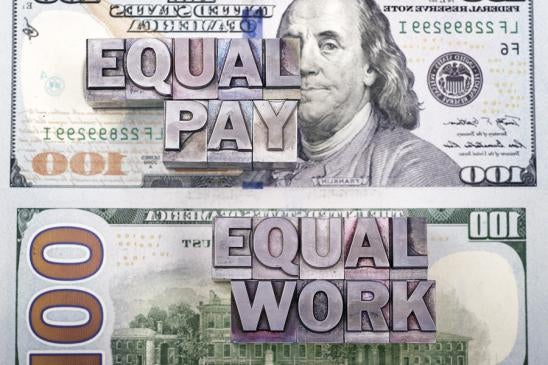In Depth
Pay equity is an issue involving the interplay of many of the most relevant concepts in law and society today: gender equality, federalism, and the balance of power between employee and employer. The lone federal law directly dealing with pay equity is the Equal Pay Act of 1963 (EPA), which simply states that it is unlawful to pay men and women differently for equal work (i.e., work involving the same skill, experience and responsibilities). Under the EPA, no employer:
…shall discriminate, within any establishment in which such employees are employed, between employees on the basis of sex by paying wages to employees in such establishment at a rate less than the rate at which he pays wages to employees of the opposite sex in such establishment for equal work on jobs the performance of which requires equal skill, effort, and responsibility, and which are performed under similar working conditions, except where such payment is made pursuant to (i) a seniority system; (ii) a merit system; (iii) a system which measures earnings by quantity or quality of production; or (iv) a differential based on any other factor other than sex.
I. EPA’s History of Mixed Effectiveness
The EPA has been somewhat effective: the 40 percent gap between males and females in 1963 has halved in the more than half-century since its passage. Yet progress has stalled in the last two decades and pay trends continue to show a sizeable gap. Notably, the stubborn 20 percent gap means women are underpaid by a combined total of $840 billion. This is not just because of the macroeconomic changes common to western post-industrial democracies. The Council of Economic Advisers report found the gender wage gap in the United States is 2.5 percent higher than average industrialized countries. Increasingly, the EPA appears to be a round peg in an increasingly square hole. Currently, however, any attempt to address the weaknesses of the EPA through legislation is a dead letter. The EPA itself has not been amended since 1972, and the only federal legislation even addressing pay equity at all is now nine years in the past.
II. The High Burden in EPA Cases
However, the EPA has grown increasingly lackluster in addressing the modern-day issues of unequal pay that have developed in a service-based economy. The standards required by the EPA have made successful gender claims difficult to win: “equal” work is a stubbornly high standard, and the limit to a single establishment is increasingly outmoded in an era of multi-facility employers. The catch-all employer defense—a differential based on any factor other than sex—affords employers broad latitude to defend themselves in court by pointing to any factor the employer deems relevant.
A recent case highlights the difficulty a plaintiff has in overcoming the EPA’s standards. In Rizo v. Yovino, Case No. 14-cv-00423-MJS (9th Cir. Apr. 27, 2017), the US Court of Appeals for the Ninth Circuit held that the EPA permits an employer to pay different wages to male and female employees for the same work if the differential is based on an employee’s prior salary. In doing so, the 9th Circuit found that while prior salary does not automatically qualify as a factor other than sex, it can constitute a defense if the employer’s use of prior salary effectuates a business policy and is reasonable in light of the employer’s stated purpose and its other practices. As such, the EPA does little to target and abate the “start low, stay low” phenomenon that locks in a structural pay gap at the start of a woman’s career or job.
Despite the failure to address the EPA’s flaws legislatively, the government has taken some recent executive action to increase equal pay. On September 29, 2016, the US Equal Employment Opportunity Commission (EEOC) announced that it approved a new EEO-1 form, which will require employers to provide salary and pay information. In addition to reporting the number of employees by gender, race and ethnicity in 10 job groupings, employers are now also required to provide employee compensation information and the number of hours worked by employees across 12 pay bands. The EEOC’s goal in gathering this additional data is to identify businesses that may have pay gaps, and then target those employers who are discriminating on the account of gender through enforcement actions. Whether this new EEO-1 program, which is scheduled to be effective March 2018 and will affect 63 million workers, will survive the change in the political climate is yet unknown.
B. State Actions
The federal government is not the only sovereign with an interest in equal pay. The states increasingly have not ceded the field to the federal government. Forty-eight states have their own pay equity laws and, in 2016 or 2017, four states passed laws which modified earlier laws and which broadened the standards to state an equal pay claim.
1. California
California made three major changes. First, it replaced the “equal work” standard with the “substantially similar” standard. Employees can now be compared even if they do not hold the same or substantially equal jobs. Second, it deleted the “same establishment” requirement, such that employees can now be compared even if they do not work at the same establishment. This means the pay of an employee can be compared to the pay of other employees who work hundreds of miles apart. It is important to note that nothing in the Act limits comparisons with other states. Finally, California limited the catch-all defense to a “bona fide” factor, meaning one (1) not based or derived from gender, (2) job related and (3) consistent with business necessity. A second law, the California Fair Pay Act, which states that “[p]rior salary shall not, by itself, justify any disparity in compensation[,]” became effective in 2016 after the Rizo appeal already had been filed.
2. Massachusetts
Massachusetts amended its Fair Pay Act in 2016 (effective in 2018) to eliminate the catch-all defense entirely and similarly redefine the “equal work” standard to “comparable.” Massachusetts also became the first in the nation to create an affirmative defense for wage discrimination claims if an employer has (1) completed a self-evaluation of its pay practices that is “reasonable in detail and scope in light of the size of the employer” within three years before commencement of action, and (2) made reasonable progress toward eliminating the pay differentials uncovered. It is also the first law in the nation to forbid employers from inquiring about wage or salary history before making an offer of employment that includes compensation, an attempt to target the “start low, stay low” phenomenon.
3. Maryland
Maryland, like California, redefined equal as “work of a comparable character” and now requires a “bona fide” factor other than sex as the defense. Moreover, Maryland became the first state to prohibit discrimination on the basis of “sex or gender identity,” such that it adds gender identity to the protected class. Nothing in the law, however, indicates how employers are supposed to factor in gender identity when it is not obvious on its face. This issue will no doubt be tested.
Maryland also becomes the first to reach beyond pay, as it prohibits employers from “providing less favorable employment opportunities,” including placing employees into “less favorable career tracks,” “failing to provide information about promotions or advancements,” and “limiting or depriving” employees of employment opportunities because of sex or gender identity. “Career tracks” is not defined, but its goal is likely targeted at the so-called “mommy track. “
4. New York
Finally, New York made less overt substantive changes, retaining the equal standard but limiting the catch-all defense to bona fide defenses, increasing the penalties for violation, and expanding the same establishment to the same geographic area, largely meaning the same county.
C. Local Actions
Cities, too, have taken steps to address the wage gap. Philadelphia and New York City recently restricted inquiry into salary history. Washington DC is, as of this writing, considering a bill to require employers to publish salary for open positions.
Private industry has taken steps as well to push wage equality. Activist investors have targeted high profile companies such as Amazon, Google, eBay, Facebook and more recently, the largest publicly traded banks, to disclose compensation data broken down by gender. Some—big names like Bank of New York and AT&T—have settled by releasing such information and pledged to take steps to address pay inequality.
What are the Next Steps?
The practical effects of state and local law, as well as private initiatives, should make employers realize that cases filed by plaintiffs will more often than not be fact disputes ill-suited to resolution before discovery. Accordingly, employers will be more likely to settle matters before discovery.
In addition to ensuring compliance with state and city law in the specific jurisdictions which have made material changes, employers should take this opportunity to conduct a pay equity study within the confines of the attorney-client privilege to ascertain whether—and to what extent—potentially troublesome pay gaps exist within the organization. Current and accurate documentation is the primary tool for supporting job specific pay differences and should be reviewed and updated accordingly.




 i
i

